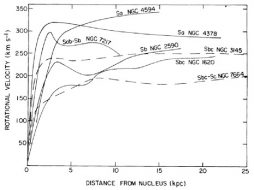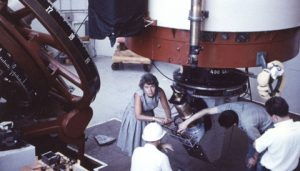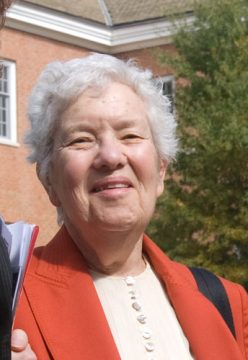Astronomy - Vera Rubin, “Mother of Dark Matter,” Dies
The holidays brought sad news to astronomers across the world after they learned that Vera Rubin, whose pioneering work led to the confirmation of dark matter, passed away.
Astronomer Vera Rubin, known for her revolutionary work confirming the existence of dark matter, died on December 25th. She was 88.
Rubin’s love for celestial motions began at a young age. In 1938, when she was just 10 years old, her family moved from Philadelphia to Washington, D.C., where she inherited a north-facing bedroom window. There, she would watch the night sky revolve, entranced by the sense of Earth’s motion. Four years later, she built her own telescope with her father and started attending amateur astronomers’ meetings.
But that isn’t to say this pioneering female scientist walked an easy path. Although her parents were supportive, Rubin received little encouragement from others to pursue her passion in astronomy. Her high school physics teacher told her to stay away from science in college. And a college admissions officer suggested she become an astronomical artist instead.
Determined nonetheless, Rubin followed in the footsteps of Maria Mitchell — the first professional female astronomer — by attending Vassar College in Poughkeepsie, New York. On a summer break she met Bob Rubin, then a graduate student at Cornell. They married after her graduation from Vassar.
Rubin completed her master’s at Cornell (her dream was to attend Princeton, but the university didn’t accept women into its graduate astrophysics program at the time) while her husband finished his PhD. The couple then moved to Maryland for Bob Rubin’s new job at the Applied Physics Lab. Thanks to a chance office arrangement, noted physicist George Gamow learned of Rubin’s master’s work on galaxies and asked to talk with her. It was a stroke of luck that ultimately led her to complete her PhD work at Georgetown University under him. Her 1954 thesis broke new ground on the spatial distribution of galaxies.
She subsequently joined the Georgetown faculty but her work remained uneventful. She focused on raising four children, who would later become scientists themselves. “It took me a long time to believe I was a real astronomer,” she told Science in 2002.
The turning point came when Rubin was invited to collaborate with Margaret and Geoffrey Burbidge at the University of California at San Diego. She and her husband spent a year working with the husband-and-wife team, who encouraged her ideas and ultimately gave her a new sense of professional accomplishment.
She returned to Maryland a changed woman, with an eagerness so strong she walked into Carnegie’s Department of Terrestrial Magnetism and demanded a job. In the following years she took multiple observing trips with collaborator Kent Ford to Kitt Peak in Arizona and Cerro Tololo in Chile. In 1965, she even became the first woman legally permitted to use the Palomar Observatory in southern California.
The new work allowed Rubin to return to her initial curiosity of stellar motions within galaxies. With new advances in technology, she was able to study the rotation of the outer reaches of galaxies much as she used to watch the rotation of the stars outside her bedroom window. Her observations of stars orbiting on the outskirts of galaxies helped spark a remarkable discovery: the vast majority of matter is invisible.
Galaxies Are Overflowing with Dark Matter
In 1933, Swiss astronomer Fritz Zwicky observed the Coma Cluster, a galaxy cluster roughly 50 million light-years across that’s filled with thousands of galaxies. He found that these galaxies move so rapidly through the cluster that it ought to fly apart. There simply wasn’t enough visible matter to hold the galaxy cluster together with its constituents zipping through it that fast. Yet the cluster was stable.
Zwicky decided there must be a hidden ingredient, which he called dunkle Materie, or “dark matter,” that held the cluster together.
The issue remained relatively quiet for the next three decades. It was Rubin, Ford, and their colleagues who gathered further evidence that individual galaxies also did not rotate as expected. Because most galaxies have a luminous central bulge composed of densely packed stars, and faint outskirts composed of far fewer stars, astronomers had largely assumed that most of a galaxy’s mass was concentrated in the center. The natural conclusion then is that galaxies should rotate much as our solar system does, where the inner planets orbit the Sun faster than the outer planets.

This figure from Rubin's 1978 paper shows rotational velocities for seven of the 10 galaxies the team studied. If visible matter were the only matter present, the curves would dive back down on the far right. Their flatness indicates that, assuming our understanding of gravity is correct, additional unseen matter exists in the galaxies.
Rubin et al. / ApJL 1978
Rubin et al. / ApJL 1978
But the team’s work showed that wasn’t the case. In their 1978 Astrophysical Journal letter, the astronomers looked at the galactic rotation curves — graphs showing the orbital speeds of stars versus their distance from the galactic center — of 10 galaxies (seven are shown at right). If the visible matter was the only character in this story, then these curves would dip down at large distances, much like it does for the solar system.
Instead, all the rotation curves are relatively flat. The stars far from the centers of galaxies, in the sparsely populated fringes, rotate just as rapidly as the stars closer in. The team’s calculations showed that galaxies must contain about 10 times as much dark matter as light matter.
Rubin is notorious for having once said: "In a spiral galaxy, the ratio of dark-to-light matter is about a factor of 10. That's probably a good number for the ratio of our ignorance-to-knowledge. We're out of kindergarten, but only in about third grade."
Over the next decade, Rubin continued to study hundreds of galaxies, amassing even more evidence for dark matter. Although the nature of that matter remains a mystery today, it has become one of the biggest buzzwords in astronomy. Observers continue to study it, much in the same way Rubin once did, and theorists are desperate to explain it.
Rubin’s Legacy
Rubin’s love for science swept over her family: all of her children grew up to become scientists. Judith Young was an astronomer at the University of Massachusetts, Amherst, until her untimely death due to cancer in 2014; David Rubin is a geologist with the U.S. Geological Survey; Karl Rubin is a mathematician at University of California, Irvine; and Allan Rubin is a geologist at Princeton University.
Her husband, a mathematician and physicist, was also one of her greatest supporters; he passed in 2008.
Rubin’s achievements earned her election (as the second female astronomer) to the National Academy of Sciences in 1981. In 1996 she became the first woman to receive the Royal Astronomical Society’s Gold Medal since Caroline Hershel in 1828. She repeatedly called for more women to join the sciences, providing encouragement and fighting problems that persist today. Sadly, she never received the Nobel Prize that many feel she deserved.
While many have praised Rubin for her remarkable discoveries, advancement for women in science, and successful juggling of career and family, she stands tallest as a role model in her unabashed love of astronomy. Her child-like curiosity and wonder present throughout her entire life will encourage many to come.


No comments:
Post a Comment